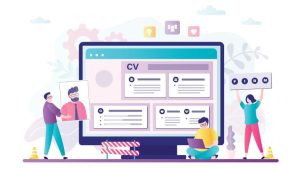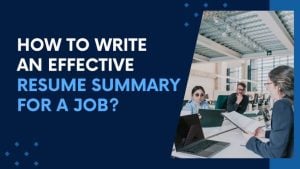How to Highlight Experience: Creating Resumes for Senior Employment Opportunities
 Publié le 7 December 2023
Publié le 7 December 2023
Move your career forward by learning how to highlight experience with the techniques for creating resumes for senior employment opportunities.
Landing your dream job can be difficult. On top of that, securing a senior-level position can be even more of a challenge, even for people with massive job experience and qualifications.
Senior-level positions almost always have high competition. Hiring managers must sift through hundreds (and even thousands) of job applications to hire one person. Sometimes, it feels like getting a job is fighting against stacked odds.
Don’t worry. In this guide, we’ll share everything you need to know about creating resumes for senior employment opportunities and score that coveted role.
Choose the Right Format
Your resume format can make the difference in standing out in a crowded job application pool. Most employers leverage an applicant tracking system (ATS) to comb through resumes for senior employment jobs.
The problem is that an ATS will automatically reject resumes that aren’t formatted correctly. To avoid this outcome, you should pick an ATS-compliant resume format.
The good news is that you can use a resume builder to automatically create an ATS-friendly resume. It does all the heavy lifting for you.
Tailor Your Resume to Individual Jobs
Sending the same resume to different employers may seem like a great idea for applying to several jobs simultaneously.
However, all senior employment jobs aren’t the same. It’s important to tailor your resume to individual jobs to find success in your job hunt.
For example, let’s say you’re applying for a corporate board secretary job.
Certain duties might remain constant, such as planning board meetings, taking minutes, and writing board resolutions. You’ll want to highlight your experiences with these tasks on your resume.
On the flip side, if you are applying for a law firm secretary job, you’ll want to tweak your experiences and skill sets to match that particular role. Allows include specific keywords found in the job description as part of your resume. This will demonstrate that you have paid attention to the needs of the company and are demonstrating how you are the right fit.
Include a Professional Summary
Think of your professional summary as your elevator pitch. It’s a short summary of your resume that explains your job profile, experience, and qualifications.
Employers can read your professional summary to learn more about your job history and how you stand out from other candidates.
Additionally, a professional summary can include your credentials, college degrees, soft skills, and other unique abilities such as additional languages you’ve learned.
Shane Barker emphasizes the importance of a professional summary: “’It’s your career encapsulated in a nutshell – a concise blend of your skills, achievements, and career aspirations, essential for making a powerful first impression.”
Put a Lot of Stock into the Experience Section
Prospective employers will heavily scrutinize the experience section in your resume. Rightfully so, they want to see if you’re truly qualified to do the job you’ve applied for.
When adding your work history, make sure you add bullet points that show objectives and key results (OKRs).
For example, instead of a bullet point saying:
- Developed marketing strategies for local businesses.
You should write:
- Developed online marketing strategies for local businesses that generated a combined $2 million in revenue.
Making your experience section more thorough and descriptive is key to convincing employers you’re highly qualified for the job.
Show Off Your Accomplishments
Your resume is the perfect place to list all the accomplishments you have, especially when applying for senior employment opportunities. For example, if you’ve created a successful company system or helped bring tremendous marketing growth for a client, you should boast about it on your resume.
You can choose to display your accomplishments from past senior employment jobs in two ways. You can place your accomplishments in bullet points next to your job responsibilities. Or you can create a section at the bottom of your resume.
You should also mention your accomplishments in your cover letter to add more context for employers (especially when changing a career path).
Highlight Your Technology Skills
Many jobs require people to have proficiency in basic technology, such as word processors (Google Docs and Microsoft Word), digital marketing tools, and even ChatGPT.
You can always add your expertise in a specific technology as a separate section in your resume. Or, you can even combine your technology skills with the certifications you’ve earned.
For example, let’s say you’ve obtained a digital marketing certification from HubSpot. Here’s how you can add this bit of information to your resume (and increase your chances of landing a senior employment job).
- Earned a digital marketing certification from HubSpot and showcased mastery in client management systems.
Eliminate Graduation Dates
When creating resumes for senior employment opportunities, your employer doesn’t need to know that you graduated high school in 1974. Simply mentioning your high school diploma (or college degree) is enough.
Remember, your resume should only contain things you’ve achieved when changing a career path. However, going back to school can have some relevance for specific jobs. As a result, you can add this experience to your cover letter instead.
For example, you can state that you’re going back to school to broaden your expertise in a career field you enjoy. This shows ambition, which many employers in the world value, along with job experience.
Advertise Your Online Presence
Most modern resumes will allow people to add their social media networks and websites.
Employers hiring for senior-level positions would jump at the chance to hire a thought leader in their space. For example, let’s say that you’re a marketing influencer. You regularly post thought leadership content on LinkedIn and TikTok.
You even have a personal blog where you share popular articles about digital marketing. You can add your social media profiles and website to your resume to bring more attention to your content from prospective employers and demonstrate your expertise in the field.
Feature a Modern Design
Traditional resume formats aren’t ATS-friendly and aren’t pleasing to the eye. Using an outdated resume can be counterproductive to your job hunt, especially when creating resumes for senior employment opportunities.
With that said, you should use a professional resume builder to design an attractive and eye-catching resume. Once your resume passes through an ATS, you’ll be much more likely to catch the attention of a hiring manager and secure a job interview.
Final Words
Creating resumes for a senior employment opportunity that highlight experience in the workplace can be a challenge. However, modern technology has made it possible to automate this process and develop an ATS-friendly resume that’ll stand out for the right reasons.
If you’re ready to secure your dream role at the executive level, following the tips in this guide is a great first step.
Best of luck with the interview process and landing those coveted senior employment opportunities!







